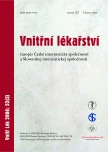A role of diabetologist in management of infections in diabtics
Authors:
A. Šmahelová
Authors‘ workplace:
Klinika gerontologická a metabolická Lékařské fakulty UK a FN, Hradec Králové, přednosta prof. MUDr. Luboš Sobotka, CSc.
Published in:
Vnitř Lék 2006; 52(5): 443-445
Category:
Diabetes and other subjects (infection, dermatovenerology and rheumatology) Hradec Králové 3 to 4 June 2005
Overview
The important role of diabetologists in management of infections in diabetics is the quality diabetes control and compensation. There are two main arrangements in the management, the correction of the former antidiabetic therapy and the quality nutrition. The insulin resistance is higher by any infection and the insulin requirement is higher in such conditions. It is necessary to stop the metformin therapy, provide basal insulinemia and level up the insulin dose at least by one third. In the heavy infections the continuous intravenous insulin infusion is recommend. The specialities of the infection in diabetics, the prevention of infection and acute diabetes complications are discussed.
Keywords:
diabetes mellitus – infections – insulin resistance – insulin dose – optimal nutrition
Sources
1. American Diabetes Association. Hyperglycemic Crises in Patients With Diabetes Mellitus. Diabetes Care 2005; 28(Suppl 1):.
2. American Diabetes Association. Nutrition Recommendations and Principles for People With Diabetes Mellitus. Diabetes Care 2005; 28(Suppl 1): S69-S71.
3. Byrne HA, Dornan TL et al. Evaluation of an Electrochemical Sensor for Measuring Blood Ketones. Diabetes Care 2000; 4 : 500-503.
4. Calabrese AT, Coley KC et al. Evaluation of prescribing practices: risk of lactic acidosis with metformin therapy. Arch Intern Med 2002; 2 : 434-437.
5. Calvert HM, Yoshikawa T Infections in diabetes. Infect Dis Clin North Am 2001;15 : 407-421.
6. Carroll MF, Schade DS. Ten pivotal questions about diabetic ketoacidosis. Postgraduate Medicine 2001; 5 : 89-93.
7. Hirsch IB et al. Inpatient Management of Adults with Diabetes. Diabetes Care 1995; 18 : 870-878.
8. Chen D, Misra A, Garg A Clinical review 153: Lipodystrophy in human immunodeficiency virus-infected patients. J Clin Endocrinol Metab 2002; 87 : 4845-4856.
9. Joshi N, Caputo GM, Karchmer AW Infections in patients with diabetes mellitus. N Engl J Med 1999; 341 : 1906-1912.
10. Kramer M, Manerji MA Infections. In: Lebowitz HE (ed). Therapy for diabetes mellitus and related disorders. 4th ed. Alexandria (VA): American Diabetes Association 2004 : 331-340.
11. Levetan C, Sala J, Wilets G et al. Inpact of Endocrine and Diabetes team Consultation on Hospital length of stay for patients With Diabetes. Am J Med 1995; 99 : 22-28.
12. Paulo De Oliveira JE, Milech A A fatal case of gastric mucormycosis and diabetic ketoacidosis. Endocr Pract 2002; 8 : 44-46.
13. Pickup JC, Williams G. Textbook of diabetes. Oxford: Blackwell Science 1997.
14. Rybka J. Hospitalizovaný diabetik. Trendy soudobé diabetologie. Praha: Galén. 2005 : 119-166
15. Šmahelová A. Akutní hyperglykemické komplikace u diabetu 1. a 2. typu. Trendy soudobé diabetologie. Praha: Galén 2001, vol. 5 : 115-153.
16. Šmahelová A, Zadák Z. Nutriční podpora diabetiků při akutních onemocněních ve stáří z pohledu diabetologa. Vnitř Lék 2002; 48 : 507-511.
17. Van den Berghe G, Wouters P, Weekers F et al. Intensive insulin therapy in critically ill patients. N Engl J Med 2001; 345 : 1539-1567.
Labels
Diabetology Endocrinology Internal medicineArticle was published in
Internal Medicine

2006 Issue 5
Most read in this issue
- Diabetic skin changes from the dermatological point of view
- Glucocorticoids and diabetes mellitus
- Diffuse idiopathic skeletal hyperostosis and its relation to metabolic parameters
- Skin complications of diabetes mellitus therapy
